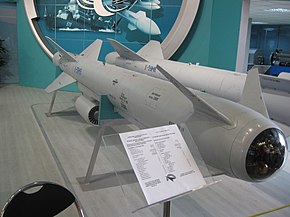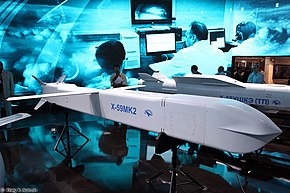Kh-59
| Kh-59 Ovod (NATO reporting name: AS-13 'Kingbolt') Kh-59M Ovod-M (AS-18 'Kazoo') | |
|---|---|
 Kh-59MK at MAKS 2009 | |
| Type | Cruise missile Air-launched cruise missile Air-to-surface missile Anti-ship missile Land-attack missile |
| Place of origin | Soviet Union/Russia |
| Service history | |
| In service | 1980-current |
| Used by | Russia, China, India, Algeria |
| Production history | |
| Designer | MKB Raduga |
| Manufacturer | Tactical Missiles Corporation |
| Specifications | |
| Mass | 930 kg (2,050 lb)[1] |
| Length | 570 cm (220 in)[1] |
| Diameter | 38.0 cm (15.0 in)[1] |
| Warhead | Cluster or shaped-charge fragmentation[1] |
| Warhead weight | 320 kg (705 lb)[2] |
| Engine | Kh-59: two-stage rocket Kh-59ME: rocket then R95TP-300[3] turbojet/turbofan |
| Wingspan | 130 cm (51.2 in)[1] |
Operational range | Kh-59ME (export): 115 km (62 nmi)[1] Kh-59ME: 200 km (110 nmi) Kh-59MK: 285 km (150 nmi) Kh-59MK2: 550 km (300 nmi) |
| Maximum speed | Mach 0.72-0.88[1] |
Guidance system | inertial guidance (then TV guidance), millimeter wave active radar seeker (Kh-59MK, Kh-59MK2 land attack version)[4] |
Launch platform | Kh-59ME: Su-30MK[1] Kh-59: Su-24M, MiG-27, Su-17M3/22M4, HAL Tejas,Su-30 MKI Su-25 and Su-30[5] Kh-59MK2: Su-57[6] |
The Kh-59 Ovod (Russian: Х-59 Овод 'Gadfly'; AS-13 'Kingbolt') is a Russian TV-guided cruise missile with a two-stage solid-fuel propulsion system and 200 km range. The Kh-59M Ovod-M (AS-18 'Kazoo') is a variant with a bigger warhead and turbojet engine. It is primarily a land-attack missile but the Kh-59MK variant targets ships.[4]
Development[]
The initial design was based on the Raduga Kh-58 (AS-11 'Kilter'), but it had to be abandoned[citation needed] because the missile speed was too high for visual target acquisition.
Raduga OKB developed the Kh-59 in the 1970s as a longer ranged version of the Kh-25 (AS-10 'Karen'),[7] as a precision stand-off weapon for the Su-24M and late-model MiG-27's.[5] The electro-optical sensors for this and other weapons such as the Kh-29 (AS-14 'Kedge') and KAB-500 Kr bombs were developed by S A Zverev NPO in Krasnogorsk.[7]
It is believed that development of the Kh-59M started in the 1980s.[4] Details of the Kh-59M were first revealed in the early 1990s.[4]
Design[]
The original Kh-59 is propelled by a solid fuel engine, and incorporates a solid fuel accelerator in the tail. The folding stabilizers are located in the front of the missile, with wings and rudder in the rear. The Kh-59 cruises at an altitude of about 7 meters above water or 100–1,000 metres (330–3,280 ft) above ground with the help of a radar altimeter. It can be launched at speeds of 600 to 1,000 km/h (370 to 620 mph) at altitudes of 0.2 to 11 kilometres (660 to 36,090 ft) and has a CEP of 2 to 3 meters.[2] It is carried on an AKU-58-1 launch pylon.[5]
The Kh-59ME has an external turbofan engine below the body just forward of the rear wings, but retains the powder-fuel accelerator. It also has a dual guidance system consisting of an inertial guidance system to guide it into the target area and a television system to guide it to the target itself.[1]
The 36MT turbofan engine developed for the Kh-59M class of missiles is manufactured by NPO Saturn of Russia.[8]
Target coordinates are fed into the missile before launch, and the initial flight phase is conducted under inertial guidance. At a distance of 10 km from the target the television guidance system is activated. An operator aboard the aircraft visually identifies the target and locks the missile onto it.
Operational history[]
Although the original Kh-59 could be carried by the MiG-27, Su-17M3, Su-22M4, Su-24M, Su-25 and Su-30 family if they carried an APK-9 datalink pod, it was only fielded on the Su-24M in Russian service.[5] From 2008–2015, Russia delivered some 200 Kh-59 missiles to China for use on the Su-30MK2; deliveries may have included both Kh-59MK and Kh-59MK2 versions.[9] The Kh-59MK2 has been test-fired by a Su-57 stealth fighter, during its 2018 Syrian deployment.[6]
Variants[]


- Kh-59 (AS-13 'Kingbolt') - original version with dual solid-fuel rocket engines. First shown in 1991; exported as Kh-59 or Kh-59E.[7]
- Kh-59M (AS-18 'Kazoo') - adds turbojet engine and larger warhead. Range 115 km.[1]
- Kh-59ME - 200 km-range variant offered for export in 1999.[4]
- Kh-59MK - 285 km-range anti-shipping variant with turbofan engine and ARGS-59 active radar seeker.[4][10]
- Kh-59MK2 - land attack variant of Kh-59MK (fire-and-forget),[4] equipped with either a 320 kg penetrating or 285 kg (628 lb) pellet warhead.[9][11]
- Kh-59M2 - Kh-59M/Kh-59MK with new TV/IIR seekers, reported in 2004.[4]
- Kh-20 - possible name for nuclear-tipped variant carried by Su-27 family.[4]
- Kh-59L - laser-guided variant that was developed.[5]
- Kh-59T - TV guided instead laser guidance variant.
- Kh-59MK2 (AS-22) - stealth standoff version, with range of 290 km, warhead weight up to 320 kg and launch weight up to 770 kg. First unveiled at MAKS 2015.[12][13]
- Kh-59MKM - penetrator version that eliminated the seeker section and fitted a 360 kg (790 lb) warhead, able to penetrate 3 m of reinforced concrete.[14]
Proposed development options for the Kh-59M/ME have included alternative payloads (including cluster munitions) but their current development status is unclear.[5][15]
Operators[]

Current operators[]
- Venezuelan Air Force
Former operators[]
See also[]
- AGM-130 TV-guided penetration missile
- AGM-84E/H/K Standoff Land Attack Missile
- AGM-62 Walleye II - TV-guided glide bomb with 83 km range
- Kh-37 variant of Kh-35U (AS-20 'Kayak') - 145 kg warhead, 250 km range
- Kh-58 (AS-11 'Kilter') - Raduga anti-radar missile, 120 km range
- Kh-35 (AS-20 'Kayak')
References[]
- ^ Jump up to: a b c d e f g h i j Rosoboronexport Air Force Department and Media & PR Service, AEROSPACE SYSTEMS export catalogue (PDF), Rosoboronexport State Corporation, p. 124, archived from the original (PDF) on 30 October 2007
- ^ Jump up to: a b "Raduga Kh-59 (AS-13 Kingbolt) and Kh-59M (AS-18 Kazoo)". Archived from the original on 1 January 2009. Retrieved 22 December 2008.
- ^ "Aero-Engine Scientific and Technical Complex «Soyuz"".
- ^ Jump up to: a b c d e f g h i "Kh-59M, Kh-59ME Ovod-M (AS-18 'Kazoo')", Jane's Air-Launched Weapons, 3 December 2010, archived from the original on 11 August 2011, retrieved 28 April 2011
- ^ Jump up to: a b c d e f Kh-59 Ovod (AS-13 'Kingbolt'), 24 October 2007, retrieved 3 February 2009
- ^ Jump up to: a b "Russian Su-57 reportedly fired cutting-edge Kh-59Mk2 cruise missile during tests in Syria". ruaviation.com. 29 May 2018. Retrieved 21 July 2019.
- ^ Jump up to: a b c "Kh-59 (AS-13 'Kingbolt'/Ovod)", Jane's Strategic Weapon Systems, 9 September 2008, retrieved 3 February 2009
- ^ "Saturn military engines for unmanned aerial vehicles". NPO Saturn website. Retrieved 28 April 2011.
- ^ "Kh-59MK extended-range Air-to-Surface Missile". Rosoboronexport.
- ^ "Kh-59MK2 Air-to-Surface Guided Missile". Rosoboronexport.
- ^ "Russian Stealth Ship Killers Debut at MAKS 2015". defense-update.com. 30 August 2015. Retrieved 21 July 2019.
- ^ https://imgur.com/2C0kUW1. Missing or empty
|title=(help) - ^ "Russia unveils Kh-59MKM upgrade variant air-to-surface missile". Jane's Information Group. 28 July 2021. Archived from the original on 4 August 2021.
- ^ Wiebe, Virgil; Titus Peachey (2000). "Clusters of Death". The Mennonite Central Committee Global Report on Cluster Bomb Production and Use. Mennonite Central Committee. Retrieved 28 April 2011.
Also known as the Kh-59M Ovod-M, the AS-18 is modernized version of AS-13 Kingbolt ... The warhead can be either a 705-lb high explosive or 617-lb cluster submunitions.
- ^ "Trade Registers".
- ^ 2011 Annual Report of Tactical Missile Corporation, "Archived copy". Archived from the original on 21 August 2012. Retrieved 31 July 2013.CS1 maint: archived copy as title (link)
Bibliography[]
- Gordon, Yefim (2004), Soviet/Russian Aircraft Weapons Since World War Two, Hinckley, England: Midland Publishing, ISBN 1-85780-188-1
- Cruise missiles
- Air-to-surface missiles of Russia
- Cold War air-to-surface missiles of the Soviet Union
- Nuclear air-to-surface missiles
- Nuclear cruise missiles of the Soviet Union
- Nuclear cruise missiles of Russia
- Air-to-surface missiles of the Soviet Union
- Anti-ship cruise missiles of Russia
- MKB Raduga products
- Television guided weapons
- Military equipment introduced in the 1980s
- Fire-and-forget weapons